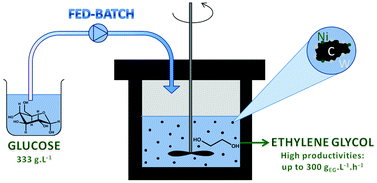Green Chem., 2013, Advance Article
DOI: 10.1039/C3GC41431K, Paper
Roselinde Ooms, Michiel Dusselier, Jan A. Geboers, Beau Op de Beeck, Rick Verhaeven,
Elena Gobechiya, Johan A. Martens, Andreas Redl, Bert F. Sels
Fed-batch reactor technology was used for the highly productive conversion of
concentrated sugar solutions into ethylene glycol using bifunctional nickel tungsten
carbide catalysts.
in a
fed-batch reactor: high productivity and reaction
network elucidation
Bifunctional nickel tungsten carbide catalysis was used for the conversion of aqueous sugar
solutions into short-chain polyols such as ethylene glycol. It is shown that very concentrated sugar
solutions, viz. up to 0.2 kg L−1, can be converted without loss of ethylene glycol selectivity
by gradually feeding the sugar solution. Detailed investigation of the reaction network
shows that, under the applied reaction conditions, glucose is converted via a retro-aldol
reaction into glycol aldehyde, which is further transformed into ethylene glycol by hydrogenation.
The main byproducts are sorbitol, erythritol, glycerol and 1,2-propanediol.
They are formed through a series of unwanted side reactions including
hydrogenation, isomerisation, hydrogenolysis and dehydration.
Hydrogenolysis of sorbitol is only a minor source of ethylene glycol. To assess the
relevance of the fed-batch system in biomass conversions, both the influence of the
catalyst composition and the reactor setup parameters like temperature, pressure
and glucose addition rate were optimized, culminating in ethylene glycol yields up to 66% and
separately, volume productivities of nearly 300 gEG L−1 h−1.


